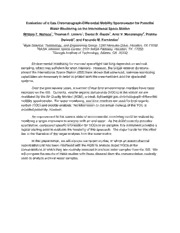
NASA Technical Reports Server (NTRS) 20140011146: Evaluation of a Gas Chromatograph-Differential Mobility Spectrometer for Potential Water Monitoring on the International Space Station PDF
Preview NASA Technical Reports Server (NTRS) 20140011146: Evaluation of a Gas Chromatograph-Differential Mobility Spectrometer for Potential Water Monitoring on the International Space Station
Evaluation of a Gas Chromatograph-Differential Mobility Spectrometer for Potential Water Monitoring on the International Space Station William T. Wallace1, Thomas F. Limero1, Daniel B. Gazda1, Ariel V. Macatangay2, Prabha Dwivedi3, and Facundo M. Fernández3 1Wyle Science, Technology, and Engineering Group, 1290 Hercules Drive, Houston, TX 77058 2NASA Johnson Space Center, 2101 NASA Parkway, Houston, TX 77058 3Georgia Institute of Technology, Atlanta, GA 30332 Environmental monitoring for manned spaceflight has long depended on archival sampling, which was sufficient for short missions. However, the longer mission durations aboard the International Space Station (ISS) have shown that enhanced, real-time monitoring capabilities are necessary in order to protect both the crewmembers and the spacecraft systems. Over the past several years, a number of real-time environmental monitors have been deployed on the ISS. Currently, volatile organic compounds (VOCs) in the station air are monitored by the Air Quality Monitor (AQM), a small, lightweight gas chromatograph-differential mobility spectrometer. For water monitoring, real-time monitors are used for total organic carbon (TOC) and biocide analysis. No information on the actual makeup of the TOC is provided presently, however. An improvement to the current state of environmental monitoring could be realized by modifying a single instrument to analyze both air and water. As the AQM currently provides quantitative, compound-specific information for VOCs in air samples, this instrument provides a logical starting point to evaluate the feasibility of this approach. The major hurdle for this effort lies in the liberation of the target analytes from the water matrix. In this presentation, we will discuss our recent studies, in which an electro-thermal vaporization unit has been interfaced with the AQM to analyze target VOCs at the concentrations at which they are routinely detected in archival water samples from the ISS. We will compare the results of these studies with those obtained from the instrumentation routinely used to analyze archival water samples.
